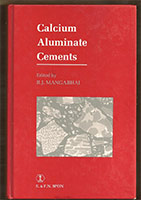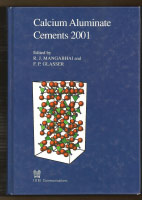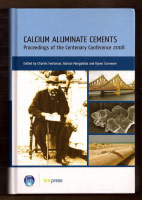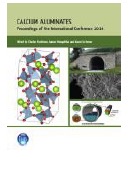Calcium Aluminate Cement Conferences
Since its invention in 1908 Calcium Aluminate Cement has been the subject of much research both in the context of the pure calcium aluminate systems but also systems in which the various attributes of calcium aluminates play a key part and in 1982 an international seminar was organised in Turin, Italy to discuss research findings of leading experts from around the world. Although participation to this event was by invitation only and restricted to some 32 delegates, it demonstrated a lively research interest in this cement and very good progress had been made in its understanding. Although various papers presented at this meeting were subsequently published elsewhere the output of the meeting was not available in a set of publically available proceedings of the meeting. Click on image of Proceedings for list of papers presented that year.
Over the years various technical publications had been available and in 1962 a very good book was published on calcium aluminate cements written by Dr Tom Robson who had worked for many years as Technical Director of Lafarge Aluminous Cement Co. Ltd in the UK. This book ran into several editions and was still the standard text at the time of the Turin seminar despite the fact that the book had been out of print for some time and there was a need to address a number of issues that had arisen since publication, not least of which was the “HAC Scare”, but also the appearance of new refractory “low-cement castables” and increased use of complex blended formulae containing Calcium Aluminate Cements.
An updated version of this book has been much needed and the task of writing this was taken on by Dr Henry Midgley. He was a very well- known – even famous, cement chemist and expert of CAC who had worked for many years at the Building Research Station at Watford, England. Now working in retirement he had drafted several chapters but sadly died in 1988 before he could complete this work.
The Midgley Symposium, London 1990
 With almost perfect timing Raman Mangabhai approached Dr Charles Fentiman of Lafarge Aluminous Cement Co Ltd with a suggestion for an international conference on Calcium Aluminate Cement and the idea quickly gained the support Dr Mike George who was the Technical Director of Lafarge Fondu International (now Kerneos) and it was decided, in recognition of his contribution to the science of calcium aluminate cements, that the meeting be dedicated the meeting to Dr Midgley. The meeting was widely called “the Midgley Symposium” and was held at Queen Mary and Westfield College, University of London, 9 – 11 July 1990.
With almost perfect timing Raman Mangabhai approached Dr Charles Fentiman of Lafarge Aluminous Cement Co Ltd with a suggestion for an international conference on Calcium Aluminate Cement and the idea quickly gained the support Dr Mike George who was the Technical Director of Lafarge Fondu International (now Kerneos) and it was decided, in recognition of his contribution to the science of calcium aluminate cements, that the meeting be dedicated the meeting to Dr Midgley. The meeting was widely called “the Midgley Symposium” and was held at Queen Mary and Westfield College, University of London, 9 – 11 July 1990.
Several important decisions were taken about the organisation of this meeting and many of these have become something of a tradition for subsequent meetings, that is; the meetings are open to all those who wished to participate, they focus on scientific and technical studies related to Calcium Aluminate Cements and maintain the highest scientific standards with published proceedings with refereed papers available for the delegates on registration. Almost equally to the technical and scientific value of the meetings, they include a convivial social programme to give the delegates plenty of opportunity to get to know each other and hopefully forge new collaborations that will open new applications.
Some 150 delegates attended this first meeting with 27 papers published in the proceedings, which covered a wide range of topics including; clinker, hydration, admixtures, durability, and important early studies on blended systems and this quickly became a standard text for those interested in calcium aluminate science. A notable feature of this meeting was the attendance of several leading researchers from Eastern Europe who were for the first time able to present the findings of their research of calcium aluminate research to a Western audience. To emphasise the social aspects of the event the delegates were entertained by the sponsors of the meeting at a lavish dinner in the main gallery at Madame Tussauds where the delegates got to dine with the famous people from around the world, we were even joined by waxworks of the Queen and Margaret Thatcher.
Edinburgh 2001
 Various research projects were probably inspired by the Midgley Symposium which had been viewed a complete success and ten years later it was apparent that there was a need for a further meeting, again with the support of Lafarge Aluminates (Kerneos) and this time joined by Heidelberger Calcium Aluminates (now Calucem). The organisation of the meeting was managed by the Cement and Concrete Committee of Institute of Minerals and Mining (IOM3) and hosted by Heriot-Watt University, Edinburgh, held on the 16 – 19 July 2001.
Various research projects were probably inspired by the Midgley Symposium which had been viewed a complete success and ten years later it was apparent that there was a need for a further meeting, again with the support of Lafarge Aluminates (Kerneos) and this time joined by Heidelberger Calcium Aluminates (now Calucem). The organisation of the meeting was managed by the Cement and Concrete Committee of Institute of Minerals and Mining (IOM3) and hosted by Heriot-Watt University, Edinburgh, held on the 16 – 19 July 2001.
The meeting attracted 49 papers which were published in the proceedings which were edited by Raman Mangabhai and Professor Fred Glasser and the meeting attracted some 135 delegates coming from 17 countries. As before plenty of time was made available for delegates to network with a civic reception and whisky tasting at the Edinburgh town hall, and a gala dinner at the Dynamic Earth centre in Edinburgh which finished with a traditional Scottish salute as we left the venue.
Avignon 2008
 The meeting was set up to celebrate the first hundred years of Calcium Aluminate Cement and it seemed fitting for this to be in Avignon, not far from the place of the Invention. It was held at the Palais des Papes on 30 June – 2 July in 2008 and this was a splendid venue for this Centenary Conference, with its rich history and state-of-the-arts Conference facilities. The facilities offered by this venue were first rate and the breadth of work presented at the last meeting demonstrated that a further meeting would be needed in a few years to follow progress being made by the various research teams. Evidence of growing interest in Calcium Aluminate Cements was demonstrated by a marked increase in the number of delegates with some 210 attending from some 25 countries, with many bringing their partners, combining the conference with some leisure time.
The meeting was set up to celebrate the first hundred years of Calcium Aluminate Cement and it seemed fitting for this to be in Avignon, not far from the place of the Invention. It was held at the Palais des Papes on 30 June – 2 July in 2008 and this was a splendid venue for this Centenary Conference, with its rich history and state-of-the-arts Conference facilities. The facilities offered by this venue were first rate and the breadth of work presented at the last meeting demonstrated that a further meeting would be needed in a few years to follow progress being made by the various research teams. Evidence of growing interest in Calcium Aluminate Cements was demonstrated by a marked increase in the number of delegates with some 210 attending from some 25 countries, with many bringing their partners, combining the conference with some leisure time.
As always a full social programme was included with a wine tasting reception on the famous bridge of Avignon and a gala dinner in the Popes dining hall at Palais des Papes.
Avignon was found to be an ideal location for such an event with international airports at Marseille, Nimes, and Lyon plus first rate road and rail connections set in the heart of Provence it is also perfect base for a holiday before or after the meeting and the organisers will be happy to offer any help and guidance if this may apply. At the last meeting the accompanying persons program was very well received and a similar program will be available for future meetings.
Avignon 2014
 It was not long after the Centenary Conference that there were calls for the next meeting. Researchers had indicated that they are ready with new material for dissemination. Since feedback was so positive about the facilities in Avignon it seemed only right to return there in 2014. The number of papers at the conference again increased and the event attracted 201 delegates from some 26 countries.
It was not long after the Centenary Conference that there were calls for the next meeting. Researchers had indicated that they are ready with new material for dissemination. Since feedback was so positive about the facilities in Avignon it seemed only right to return there in 2014. The number of papers at the conference again increased and the event attracted 201 delegates from some 26 countries.
At the end of the meeting feedback indicated that a shorter time was desirable between conferences and time frames between 2 and 6 years was proposed, but from comments received it was clear that delegate would welcome the next conference being in another location, as for some getting to Avignon presented some travel difficulties. Nevertheless, the Avignon is a hard place to beat so the search was on for a suitable location that could match Avignon, both in terms of venue, accessibility but also local appeal as somewhere special to visit.
